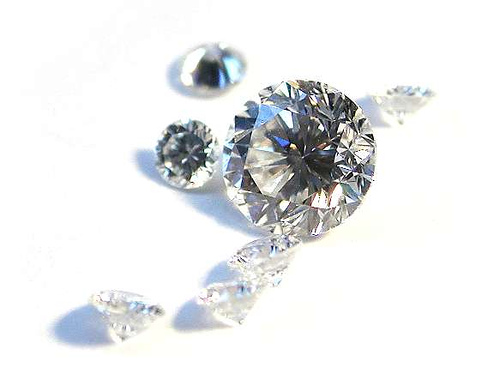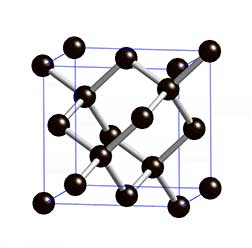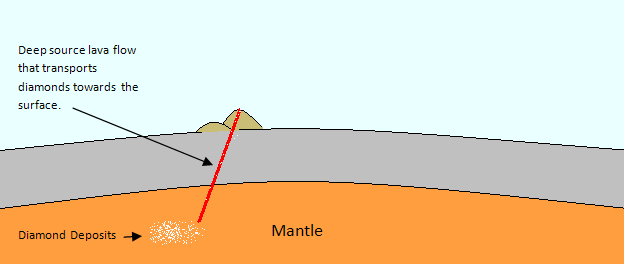Diamond formation occurs naturally in the earth’s crust but it is now possible to produce diamonds artificially in labs from any carbon.
Diamond Formation in The Earth’s Crust
Diamond Formation through Plate Tectonics
What Are Diamonds
Diamond formation occurs from the same element as coal and graphite (carbon) but under immense pressure and heat energy, normally only found naturally in the depth of the earth or in outer space, that carbon becomes the strongest material on earth.
Diamonds immense strength is due to the complex lattice shown on the left. This pattern continues throughout the diamond and each carbon atom (shown as black spheres) is bonded (shown as grey tubes) in such a way that gives the entire structure unrivalled strength.
Age and Origin of Diamonds
Diamonds are not formed by coal as commonly thought. In fact most diamonds were formed before plant life, and therefore any possibility of coal, began. Through radioactive dating it has been possible to calculate that most diamonds date back to the Precambrian eon which means they were formed approximately 100 million years before life. Coal is a sedimentary rock that is formed of carbon from decomposed organic material. Diamonds however are found in igneous rocks which are formed from cooled molten lava.
Diamonds are formed in the Earth’s mantle, approximately 90 to 120 miles below the surface. This region, known as the diamond stability zone, is characterized by extreme temperature and pressure conditions. The process begins with carbon atoms being subjected to intense heat and pressure, causing them to rearrange their molecular structure. Over millions of years, carbon atoms arrange themselves into the unique lattice structure that gives diamonds their extraordinary strength and beauty.
The Role of Volcanism
Volcanic activity plays a crucial role in the transportation of diamonds to the Earth’s surface. Deep-rooted volcanic eruptions, known as kimberlite eruptions, bring diamonds closer to the surface. Kimberlite, a volcanic rock, carries diamonds from the mantle to the Earth’s crust over a relatively short period of time. As these volcanic eruptions occur, they deposit diamond-bearing rocks, known as kimberlite pipes, on the surface, leading to the discovery and mining of these precious gemstones.
The Diamond Journey: From Rough to Refined
Mining and Extraction
Diamond mining involves several techniques, including open-pit mining and underground mining. Open-pit mining is utilized when diamond deposits are closer to the surface, while underground mining is employed for deeper deposits. Once extracted, the diamond-bearing ore undergoes crushing and processing to release the rough diamonds embedded within.
Sorting and Evaluation
After extraction, the rough diamonds undergo a meticulous sorting and evaluation process. Each diamond is graded based on the famous 4Cs – carat, clarity, color, and cut. Highly skilled gemologists carefully examine each diamond to determine its quality and value. This evaluation process ensures that only the finest diamonds make their way to the market.
Cutting and Polishing
Diamond cutting and polishing is an art form that enhances the beauty and brilliance of the raw gemstone. Master craftsmen cut the rough diamonds with precision, carefully shaping them into various cuts, such as the classic round brilliant, princess, or emerald cut. The cut diamonds are then polished to enhance their luster and sparkle, transforming them into the dazzling gems we are all familiar with.
Diamond Formation in The Earth’s Crust
Some natural diamonds are actually formed deep inside the earth’s mantle (about 90miles deep) where the pressure and heat (approximately 1050°C which is normally found nowhere else on earth) is sufficient to produce them. They are then brought closer to the surface by deep volcanic activity which is why they are usually found within igneous rocks. Volcanic eruptions which are needed to transport these diamonds to the surface are extremely rare and as yet have not been observed, however we have only had the technology or knowledge required in recent years.
Diamond Formation through Plate Tectonics
Some very small diamonds are thought to have been created below the oceanic plates and these diamonds are produced at lower depth under the pressure from the plate movements.
Some diamonds have been found on the earth’s surface around impact crater site. They are produced when a large meteor collides with the earth producing a massive burst of energy well in excess of that required to produce diamonds.
The public domain image is of a diamond mine in Russia. It is the world’s deepest diamond mine at approximately 2000ft.
Diamond Formation in Space
NASA has found many tiny diamonds (0.0000000001 meters in diameter) in samples of meteorites. It is believed that these tiny diamonds are formed during collisions of two extra terrestrial bodies which are fairly common in space.





